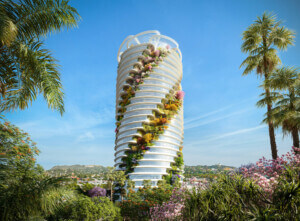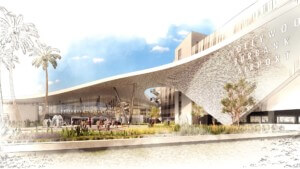“It was important to do away with the corners,” stressed Rafa Esparza, as we walked through his immersive work entitled i have never been here before, under construction and on view at LACE, Los Angeles Contemporary Exhibitions, on Hollywood Boulevard through September 13.
Esparza, a Los Angeles–based multidisciplinary artist, is busily transforming the gallery by building two curving adobe brick walls. His construction is a tour-de-force meditation on the place of art, the labor of bodies, and the steadfast mobilization of communities—as both witnesses and collaborators.
The exhibition, curated by Shoghig Halajian, began inconspicuously enough on July 8. Visitors familiar with Esparza’s previous performance works for site-specific environments were greeted by a roomful of several hundred bricks, installed in six cubic stacks on construction pallet plinths, as if awaiting further instructions.
These neat volumes, described by Halajian as “contained objects, stripped of their labor,” were the first batch to be transported from the Bowtie Project site along the L.A. River, epicenter of the brick production that itself was a key performative component of the work.
There were also eight unframed color photographs on the walls, depicting the artist in the same room at an undefined earlier moment: crawling at bucket-level, mixing messily, kneading muddy earth across a marked-up floor.
The process of making adobe bricks is methodical, the manual labor physically demanding. Esparza is working together with extended family members alongside local collaborators and—most notably—with his father, from whom he inherited the knowledge of the construction technique. Together at the Bowtie site they dig out the earth and sift out the rocks. Manure and hay are culled from the stables of a family friend in the San Gabriel Foothills. Water comes straight from the river nearby. After mixing everything to get the consistency just right, it’s poured into twelve-by-sixteen-by-four-inch wooden molds.
Despite what may seem like a drawn-out ordeal, Esparza adds, “I actually feel like we’ve been moving at a quick pace, but more importantly, it’s our own pace.” Each brick hardens in open air for several days before the team stacks and trucks them over to LACE’s bustling Hollywood Boulevard location along the Walk of Fame. There, the team work the walls up to their projected ten-foot height. “My dad doesn’t like it when I use the cracked bricks,” says Esparza, picking one up from a new shipment. “But I’m going to use all of them!” Ricardo Bracho, a theater artist who comes by for a meeting, chimes in: “Yes! Even the ugly ones! Little by little it all becomes one big brick.” Course by course along the cracks and connections, Esparza trowels on adobe in slip form as a mortar. You might arrive to find the team mid-task and strike up a conversation. Other times they’re off on lunch or running a shipment across town: tools, wheelbarrows, and water pails are strewn about, and the radio is left on.
With i have never been here before, Esparza’s form of architectural address is to welcome everyone into a place that is at once strange and also strangely comforting. He recalls a recent encounter, which encapsulates his thoughts on art and its accessibility: “The other day we were out on Hollywood Boulevard pushing a wheelbarrow full of bricks into the gallery, and a family there stopped me and asked, in Spanish, what is this doing here? We had this instant connection. And it’s the same people who might feel distant from what galleries give and do. I’m looking at who can have an immediate response to the earth, to this material.”
“At times like this, it feels almost inappropriate to make work inside here,” says Esparza of the gallery space. But the key word here is “almost.” It girds his skepticism about institutional norms at the same time that it fuels an ambition to engage them head-on. “If we are talking about changing these spaces,” he asks, “what really are the alternatives? Can we imagine them? What do they look like?”
Without prompting, he adds: “I wasn’t thinking about architecture specifically when I began to use bricks—just about space.” The statement is accompanied by a mischievous look: it’s true, to be sure, but Esparza’s previous works have often taken forms that relate directly to specific architectural acts, whether through their material makeup, their social position, or the symbolic heft. For a recent work, located next to the Twin Towers LA County Jail, Esparza’s standing body was encased in concrete to chest-height, after which he chiseled himself free; for another, a performance at the Getty, he ferried himself across the travertine courtyard via adobe tiles, dressed in a spacesuit. He draws attention from these structures of power, outdoors and in public, and distributes it back to the labors of the individual or collective body: whether it’s a body nearby it, or pushing against it, or talking with, or getting up in the face of it.
As the work casts new light on vernacular building materials and processes, Esparza also seeks to wrest both institution and visiting audience from their respective comfort zones. “It is in some ways an uncomfortable project,” Halajian says. “On a basic administrative level, we’re constantly having conversations about the level of dirt—how we’re treating and preparing the space. For example, do we clean daily or cover it up? Do we deal with the trails in and out of spaces, into the back and the project room? How do we address our boundaries?”
And the title? Esparza grins, quickly clarifying: “I’ve actually been here plenty of times!” He describes how his first performance in a gallery was at LACE in 2010, for the marathon performance event Gutted. “Actually it was here that I received my first truly inspiring experience of a community of makers. To find myself surrounded by this, I thought to myself, this is my education! So I have been here before, but I am imagining it as a new place, one that draws on a history, a labor, a class, and an architecture—all of which I wanted to be responsive to.” But the humility in his response foregrounds the title’s proposal: how can we inject even familiar spaces with new, unfamiliar energies?
Appropriately, i have never been here before will serve as the backdrop for the Resonant Forms festival during its final weekend, featuring an impressive array of experimental sound and performance artists. At exhibit’s end, Esparza plans to chisel out, store, and ultimately repurpose each of the five thousand bricks.










